Carbonara pasta
The queen of Italian tables
It is the result of combining pasta (spaghetti, rigatoni, mezze maniche), egg yolks, pecorino cheese, guanciale bacon and pepper. Said in this way it sounds easy, but is it really so? I want to take you with me to discover this wonderful recipe, prepare it together and rejoice in the gustatory pleasure of this dish.
“Some say that perhaps this dish owes its name to lumberjacks who went to the Apennines to make charcoal and brought with them bacon, eggs and pecorino cheese, with which to season pasta….
Another hypothesis: “when Rome was liberated, food shortages were extreme, and one of the few resources were military rations, distributed by the allied troops; these included eggs (powdered) and bacon (smoked bacon), which some unknown genius would have had the idea of mixing by seasoning the pasta.”
“There are those who say that perhaps this dish owes its name to lumberjacks who went to the Apennines to make charcoal and who brought with them bacon, eggs and pecorino cheese, with which to season the pasta… Another theory traces carbonara to a Neapolitan nobleman, Ippolito Cavalcanti in his book “La cucina teorico pratica.” But apparently in the book the closest recipe has neither guanciale nor pancetta, and the eggs are overcooked. The most fascinating theory, which would explain the absence of traces in popular tradition, traces carbonara back to liberation by the Allies. This is how Marco Guarnaschelli Gotti’s encyclopedia of gastronomy2 describes this hypothesis: “when Rome was liberated, food shortages were extreme, and one of the few resources were military rations, distributed by the allied troops; these included eggs (powdered) and bacon (smoked bacon), which some unknown genius would have had the idea of mixing by seasoning the pasta.”
Mystery of the carbonara
“Some say that perhaps this dish owes its name to lumberjacks who went to the Apennines to make charcoal and brought with them bacon, eggs and pecorino cheese, with which to season the pasta…Another theory traces carbonara to a Neapolitan nobleman, Ippolito Cavalcanti in his book “La cucina teorico pratica.” But apparently in the book the closest recipe has neither guanciale nor pancetta, and the eggs are overcooked. The most fascinating theory, which would explain the absence of traces in popular tradition, traces carbonara back to liberation by the Allies. This is how Marco Guarnaschelli Gotti’s encyclopedia of gastronomy2 describes this hypothesis: “when Rome was liberated, food shortages were extreme, and one of the few resources were military rations, distributed by the allied troops; these included eggs (powdered) and bacon (smoked bacon), which some unknown genius would have had the idea of mixing by seasoning the pasta.”

MOUNTAIN FEEDING
The food of the mountain farmer was generally: “meager and not very nutritious; variety of food is rare for them, and is found only in a few somewhat better-off families (…) Ordinary food is almost solely based on corn. This cereal,reduced to flour, is kneaded with water and in the form of a flatbread, called pizza, is baked in the oven to make bread and served in all daily meals. Other maize flour is cooked in water, rarely seasoned with salt and oil, lard, cottage cheese or vegetables, and forms polenta, which is the farmer’s daily soup.” The frugality of mountain farmers’ meals is evident. The use of cured meats and fish was scarce. Almost unknown was meat as was the use of wine. This is the result of two different analyses of the peasant diet of the central Apennines, but the same observations apply to other populations in those areas: “the diet is always incomplete, often consisting of unhealthy foods. Wheat and corn are ordinarily bad, legumes bad, cheese meager; and so on and so forth. Poor farmers generally, of the few grains and foodstuffs they produce, sell the best ones to scrape together a few liras, and retain and often buy for their own and their families’ food all that there is worse. This is the general regime of families; even sadder is that of laborers.”
THE COAL MINERS OF THE APENNINES.
The orographic conformation of the peninsula is characterized by the presence of a long Apennine ridge with a mostly temperate climate. The presence of peaks that are not too high and a relatively favorable climate (rainfall and sunshine), have in fact favored the development of a large forest cover.
The presence of this dense tree vegetation has been one of the main sources of sustenance for the Apennine populations. In fact, among the activities related to the exploitation of this resource, the work of the charcoal burners stands out for its typical character.
In the diet of these people some have considered to locate the origin of the recipe: and in their profession that of the name.

The life of coal miners
Getting charcoal from wood has been one of the main subsistence activities of Apennine mountain communities for centuries. In the months from early spring to late fall, a large part of the male population would move into the bush to gather wood to turn into charcoal.
A shack repurposed year by year, a straw mattress and a frugal diet characterized the lives of these men for entire months of the year. The already poor diet was obtained from the undergrowth or from the occasional supply from local farmers.
Pepper, for example, is almost never mentioned in early sources of the dish. Since it was a rather expensive spice in those years, its use was the prerogative of a few families, who tended to use it sparingly, a fact that was unlikely to alter its coloring.
The profession of the charcoal-burner, understood as one who brings coal for domestic consumption, is widespread in all urban areas of the country, this at least until the 1970s.
As we know it today, carbonara is undoubtedly a traditional Roman specialty.

What wines to pair with this sensational first course
To support the intense flavor of the individual ingredients in this dish, a well-structured wine with good acidity is needed to balance the fatty part given by the guanciale.
Perfect, in this sense, is a Vermentino di Gallura DOC, although the freshness of Chardonnay also goes very well with this pasta.
Alternatively, the minerality of a Greco di Tufo from Campania is excellent, or, wanting to go bubbly, green light to a Metodo Classico such as a Franciacorta DOCG, able to cleanse the palate of the unctuousness of the pork.
Red wine and pasta carbonara
The pairing for those who like to make risky choices is red wine. Daring because red runs the risk of causing our taste buds to lose the characteristic creaminess of the yolk.
The important thing is to go for wines that are structured but with tannins that are not too excessive and would counteract the delicacy of the egg.
Choose a spicy and ripe wine, such as a Syrah DOC from Lazio or a Schioppettino DOC, a deep ruby-red wine from Friuli, whose nose recalls notes of berries and morello cherries: perfect!
Want to reserve a table?
Book your table directly from our website




